26 Classic of Mountains and Seas
Patrick McDonald
The Classic of Mountains and Seas is probably the most relevant text to learn about in this class. The subjects it talks about range from geography to medicine. But the most important part of the text is its cataloging of many mythical creatures from all over China. The creatures contained within it are referenced in many places throughout Chinese folklore and belief. One could initially think that all these people were influenced by this one text but it makes more sense for it to be the other way around. What makes it different from a book we may imagine today is that it was not written all at one time. Its contents were expanded with new creatures and folklore as time went on and cultures changed. So when one person would mention a creature, its traits would be solidified and the information would find its way into the Classic eventually. A good comparison of the text would be to Wikipedia. Just like Wikipedia, the Classic has things added to it as more information is available and new creatures come to light. And just like Wikipedia, The Classic of Mountains and Seas is extremely influential.
Some of the Creatures that Inhabit this text
To help understand this text, it is a good idea to learn just what kinds of creatures the book describes. However, creatures are just a part of the text. Another important aspect are mountains and seas where the creatures can be found. One example in the text is the Poison-eagle. “It has the basic form of an eagle with a horn, and though it makes a sound like a baby, it is a man-eater.”[1]
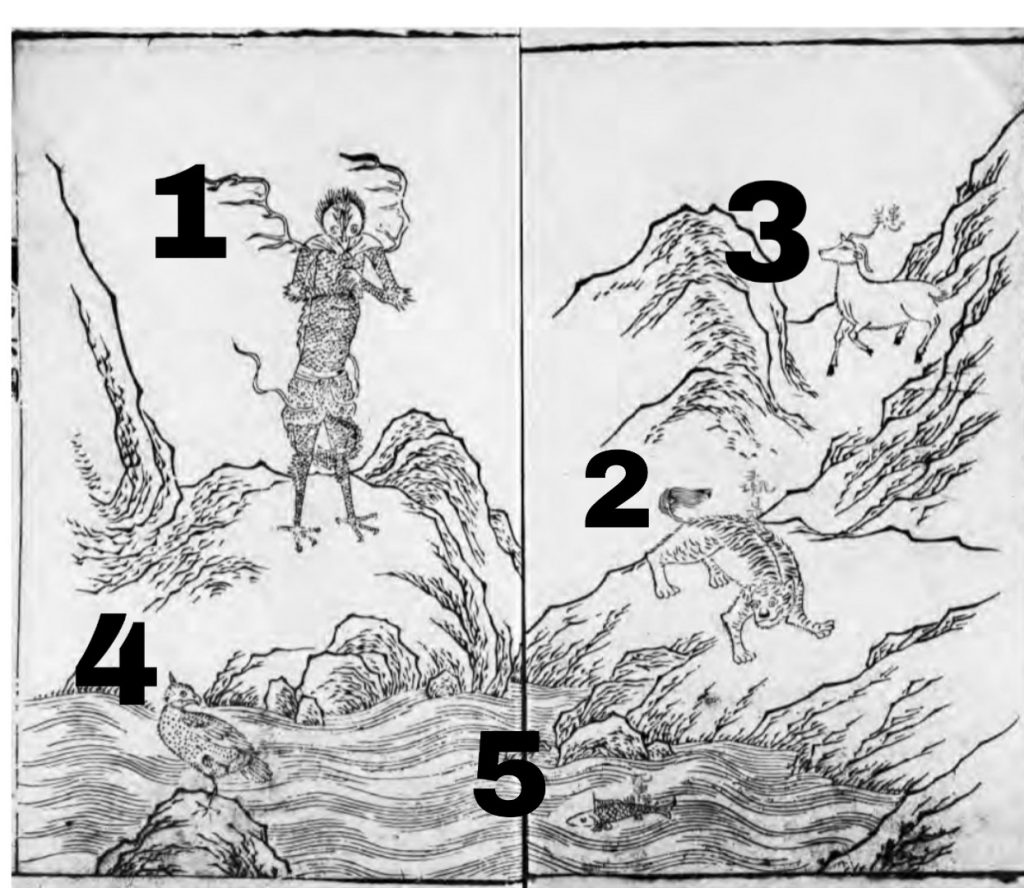
This creature is like a chimera that has the aspects of normal creatures combined. An eagle is not that strange to see but what makes it odd is its horn and that it can make the noise of a baby. The danger though really comes from its diet of people. This leads the reader to imagine its fearsome hunting technique. Perhaps it lures travelers with the sound of a crying baby. When its victim follows the call to an open clearing, the bird dive-bombs the person and impales them with its horn before feasting on its meal. Luckily, not every creature that is in the Classic is a terrifying man eater. Some actually have medicinal properties. “The Bursting River emanates from here and flows eastward into the Yellow River. In it dwell many Human-Fish. They resemble catfish with four legs and make a sound like a baby. Eating it will cure idiocy.”[2] Many creatures have medicinal uses, so when they are combined with mythology and folklore, the book also serves partly as a guide on traditional Chinese medicine. Hundreds of creatures are equally or more strange populate this text. So this raises the question: where did all these creatures come from?
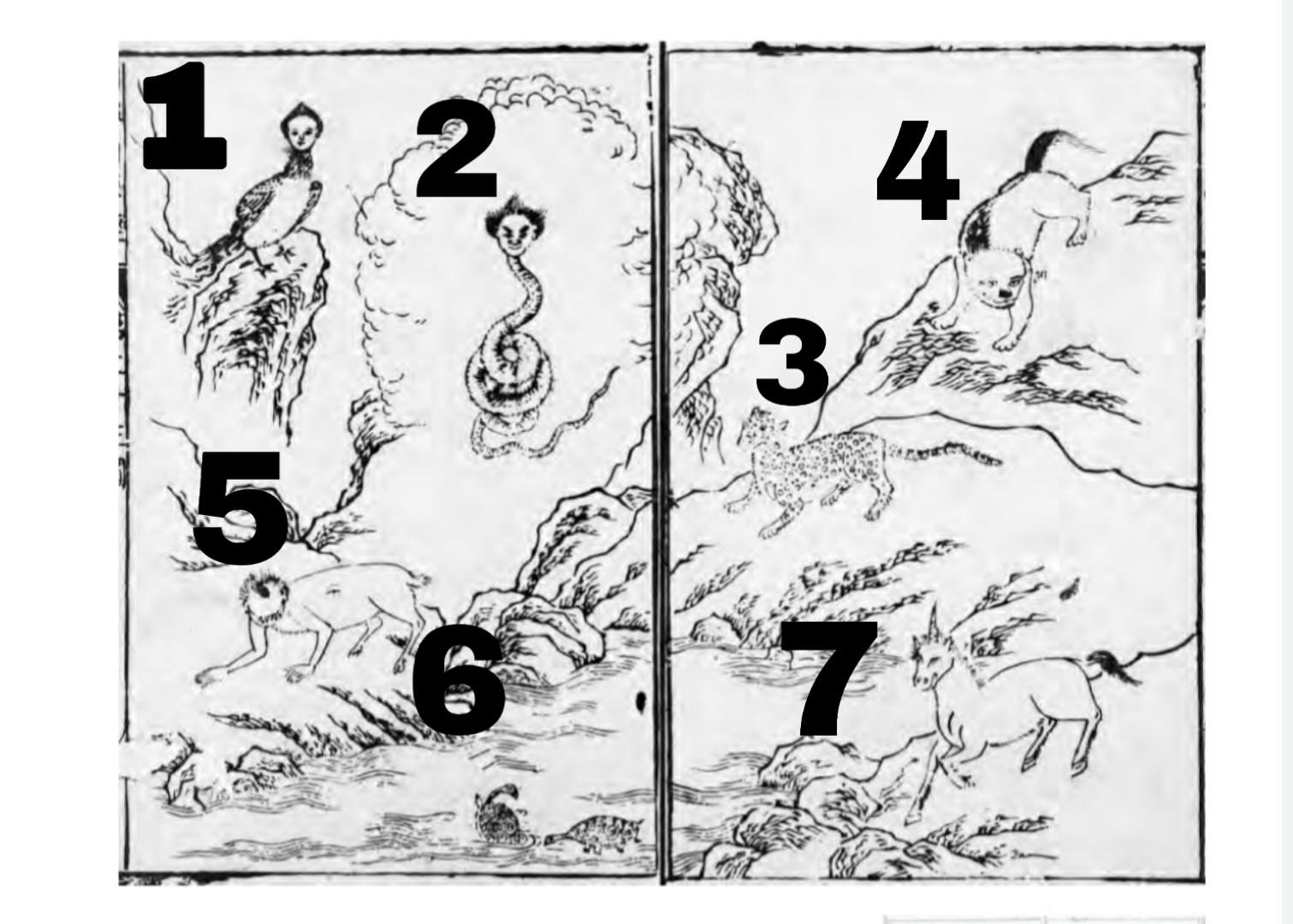
A Collective Work
The Classic of Mountains and Seas is similar to the textbook for this class. It was added to by many different people over many years. Some editions had illustrations to depict the creatures, while others did not. So if it was added to by many people, where did all these creatures come from? While there are no real names attached to the text, we know that it was mostly compiled between around 400 BCE to 100 BCE. After the main text was compiled, people still re-edited and reprinted it, up until our own day. With such a long development period, it makes sense that creatures would be added in, depending on the geographical location of the writer. For example, a writer in eastern China may know of mythical beasts and gods that someone in the west may never have heard of. Some of these creatures could have been based on people with different cultural beliefs and outfits or people with physical deformities. One person may have heard that in a village that there was a man with a horn growing out of his head. Beliefs and traits would be invented by the people who would hear rumors about this man. Seeing this beings lacking in the text, the author could add him in along with the associated folklore and medicinal traits that he believes them to have. A good example of a creature added in is the Man-fish. This creature is first mentioned by Sima Qian. In regards to it he says, “‘Man-fish’ oil was used for lamps, which were calculated to burn for a long time without going out.” [3] This is a trait of the man-fish that does not make it into the Classic. People of different backgrounds know different things about the creatures that another person may not know. The Classic of Mountains and Seas try to combine all the knowledge into one source.
Purpose of the text
So this text was compiled to put in almost every strange creature the writer could find information on. The main question is: why? There was a certain mindset with books at the time. The idea was that books should have as much information crammed into them as possible. This idea persisted later in history with Li Shizhen’s Compendium of Materia Medica. The Classic of Mountains and Seas “was compiled during what I have described as the “encyclopedic era” when Chinese working in every category of text aimed to produce comprehensive compendia that distilled everything worth knowing into a single work.”[4]. The main goals of the Classic’s many authors throughout history has been to make the text into a one stop book that has all one could need about mythical creatures. Along with creatures as a core part of the text, medical knowledge is a core part of the creatures. For instance, eating the man-fish cures idiocy and eating the Xianfu-fish stops vomiting. These details about the creature’s medical properties helps make the Classic seem more authoritative and complete.
The Classic as a Map
A common belief of Chinese culture is the centrality of China and its civilization. The Classic is more evidence of this idea. The Classic‘s geography is not really meant to be a depiction of real geography, “Rather, the SHJ [=Shanhai jing = Classic of Mountains and Seas] conveys an ideal organisation of terrestrial space characterised by a quite complex, yet remarkably regular structure”[5]. It depicts 4 mountains to each of the cardinal directions.
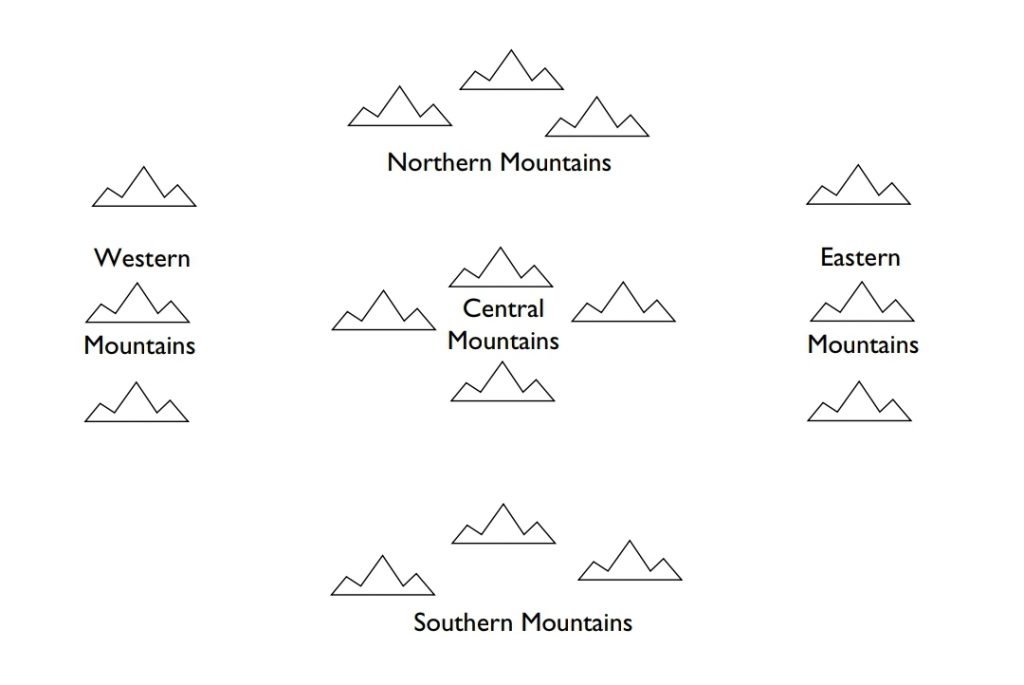
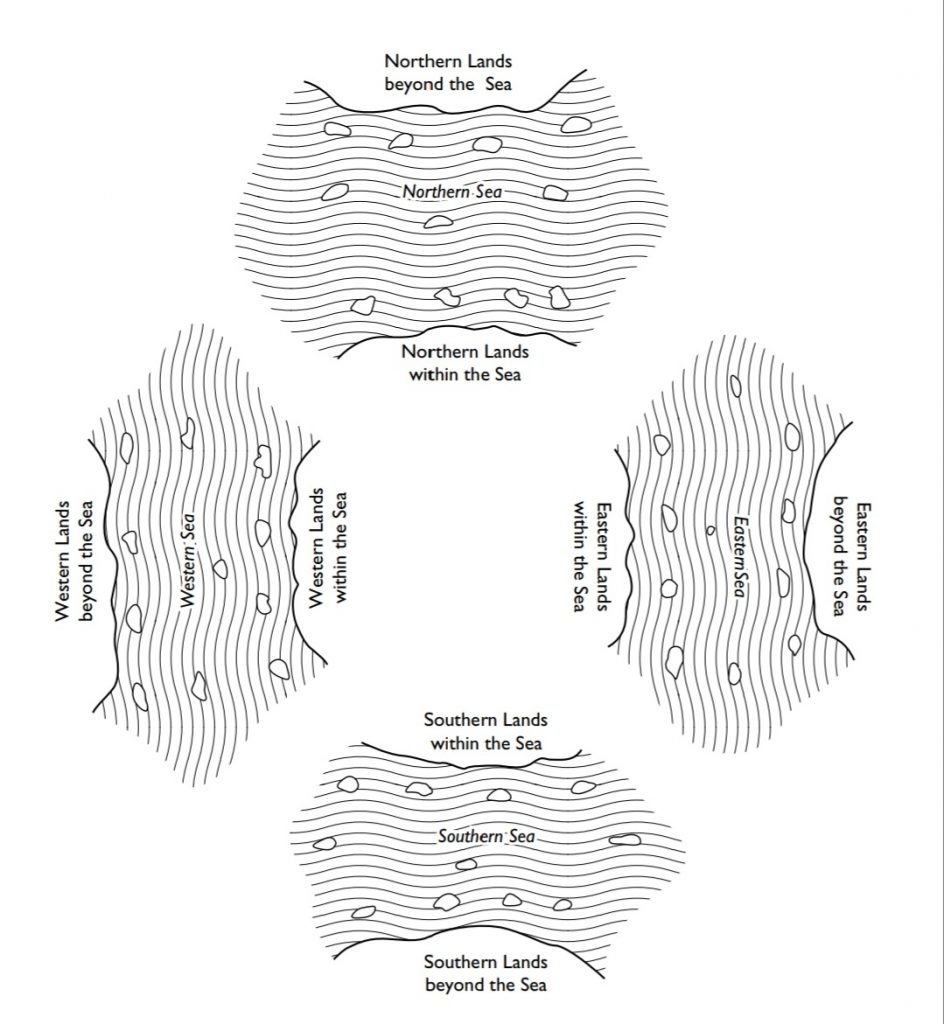
Beyond these mountains are the seas. Beyond the seas are the wilds. Everything is symmetrical which is not how geography actually is. The real goal is to showcase distant places and the strange qualities of the people that live on the outskirts of the known world. The qualities of these strangers would sometimes serve as inspiration for the creatures where the text describes “barbarians in distant lands who took on the attributes of the animals with whom they lived”[6]. For example, the people who relied on water and had tattoos of fish in the south became the man-fish. So while it is not as accurate as Google maps, the Classic serves as a map of Chinese belief about the unknown territories around them.
Importance of the Classic
The Classic of Mountains and Seas has an interesting place in Chinese culture and history. Official court historians and the literate class mention it in disparaging terms although they likely read it on the side. Even though it contains the word “classic” like The Classic of History (Shujing) or The Classic of Poetry (Shijing), it was never officially part of the Confucian canon. Its unofficial status possibly gave it an edge over other texts. A change in a famous Confucian work would be noticed and would likely cause an uproar. Due to the Classic’s status as unofficial, it could be edited without much fuss. Since it was able to be added to over centuries, the text could have creatures that were only mentioned in one other place. If that text was lost, the creature could have vanished from history. Luckily for historians today, The Classic of Mountains and Seas serves as an archive that has kept many unknown creatures alive.
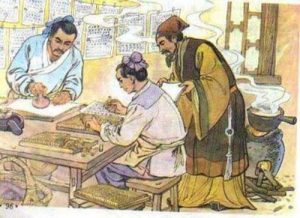
In conclusion, The Classic Of Mountains and Seas is a quintessential text for this class. It contains a massive amount of strange beings and locales to discover. Its geographic layout gives more evidence of the fundamental view in Chinese history of China being the center of civilization. The text also shows how the Chinese viewed the cultures around them. The history of the text being added to over the centuries makes it a bit of an oddball among texts yet it adds to its value historically.
Bibliography
Bray, Francesca, Vera Dorofeeva-Lichtmann, and Georges Métailie. Graphics and Text in the Production of Technical Knowledge in China: The Warp and the Weft. Sinica Leidensia 79. Leiden ; Brill, 2007. https://doi.org/10.1163/ej.9789004160637.i-772.
Lewis, Mark Edward. The Construction of Space in Early China. SUNY Series in Chinese Philosophy and Culture. Albany, NY: State University of New York Press, 2006.
A Chinese Bestiary: Strange Creatures from the Guideways through Mountains and Seas = 山海經. Edited and translated with commentary by Richard E. Strassberg. Berkeley: University of California Press, 2002.
Sima Qian, “6: Basic Annals of Qin”. In Records of the Grand Historian (Shiji). Translated by Burton Watson. New York: Renditions-Columbia University Press, 1993.
- A Chinese Bestiary: Strange Creatures from the Guideways through Mountains and Seas = 山海經, edited and trans. Richard E. Strassberg, (Berkeley: University of California Press, 2002), 125. ↵
- A Chinese Bestiary, 130. ↵
- Sima Qian, "6: Basic Annals of Qin," in Records of the Grand Historian, translated by Burton Watson, revised ed. (New York: Columbia Univ. Press), 63. ↵
- Mark Edward Lewis, The Construction of Space in Early China, SUNY Series in Chinese Philosophy and Culture (Albany, NY: State University of New York Press, 2006), 285. ↵
- Vera Dorofeeva-Lichtmann, “Mapless Mapping: Did the Maps of the Shanhaijing Ever Exist?,” in Graphics and Text in the Production of Technical Knowledge in China: The Warp and the Weft, ed. Francesca Bray, Vera Dorofeeva-Lichtmann, and Georges Métailie, Sinica Leidensia 79 (Leiden ; Brill, 2007), 218 ↵
- Lewis, The Construction of Space in Early China, 235 ↵
